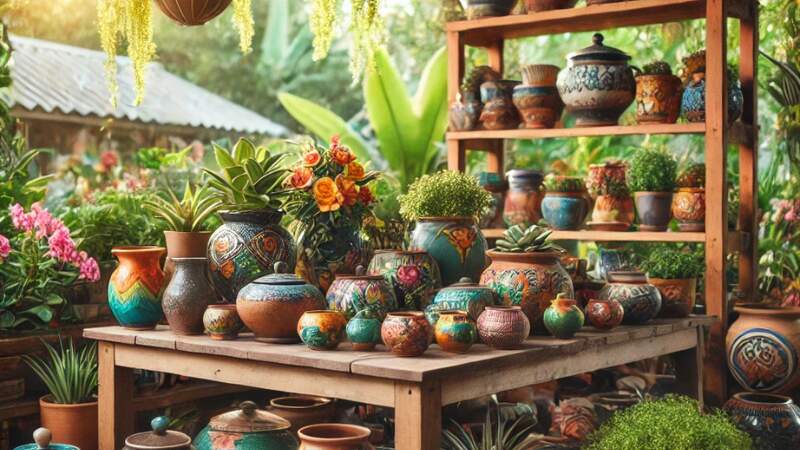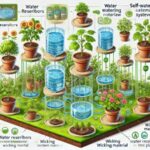Why Ceramic Plant Pots Are Perfect for Your Plants Ceramic plant pots are a staple in the gardening world, loved for their aesthetic appeal, versatility, and functionality. Whether you’re a seasoned gardener or a beginner raising your first plant, understanding the benefits of ceramic pots can enhance your gardening experience.

These Ceramic plant pots serve as a decorative element and provide the perfect growing conditions for various plants. Their moisture-retaining abilities and ability to regulate temperature make them ideal for indoor and outdoor gardening.
Additionally, the wide range of designs and finishes available ensures a ceramic pot to suit every decor style. From small succulents to large shrubs, ceramic pots provide the perfect home for your green companions.
They’re also a durable option, offering durable and timeless appeal that lasts for years. Embrace ceramic pots to create a harmonious blend of style and functionality in your gardening journey.
Table of Contents:
1. Introduction to Ceramic Plant Pots
2. Benefits of Using Ceramic Plant Pots
3. Types of Ceramic Plant Pots
4. Best Plants for Ceramic Pots
5. Ceramic vs. Other Plant Pot Materials
6. Styling Ceramic Pots for Home and Garden
7. How to Care for Ceramic Plant Pots
8. Common Concerns and How to Address Them
9. Where to Buy Quality Ceramic Plant Pots
10. Conclusion: Enhance Your Gardening with Ceramic Pots
Introduction to Ceramic Plant Pots Ceramic plant pots are made from clay and fired at high temperatures to create a durable, non-porous material. These pots are often glazed, which enhances their aesthetic appeal and provides additional protection from water damage and wear.
Ceramic plant pots have been used for centuries across cultures. They are lauded for their ability to support plant health while serving as decorative elements. Their timeless appeal makes them a favorite choice for gardeners and home decorators.
The beauty of ceramic plant pots lies in their ability to combine functionality and art, available in an array of designs, colors, and finishes. They easily blend into various decor styles, from rustic to modern. Beyond their form, these pots play an important role in plant care, offering a stable environment for roots to thrive.
The goal of gardening is not just to grow plants, but to create a haven of joy and comfort, and ceramic pots are key to achieving that balance. Whether indoors or outdoors, these pots transform spaces into serene, green havens.
2. Benefits of Using Ceramic Plant Pots
Aesthetic Appeal: Ceramic plant pots come in a variety of designs, ranging from classic to contemporary, making them a great choice for elevating home decor. Their vibrant colors and intricate finishes can complement any room or outdoor setting, adding personality and style to your space.

Unlike plastic or terracotta pots, ceramic pots exude a premium, high-quality look that works beautifully with modern and traditional decor. Whether you’re crafting a cozy nook indoors or creating a stunning patio garden, ceramic pots fit seamlessly into any design aesthetic.
Their versatility is unmatched. You can choose from glossy, matte, or textured finishes to perfectly match your interior and exterior themes. Minimalist designs add subtle elegance, while bold patterns or colors make striking statements.
In addition to holding plants, ceramic plant pots serve as standalone decorative items, ensuring that your home or garden looks sophisticated and appealing. Their ability to combine functionality with artistic beauty is why they are a favorite for plant lovers and decorators alike.
Moisture Retentions: Unlike plastic pots, ceramic plant pots help retain moisture in the soil due to their slightly porous nature, allowing water to drain out slowly while preventing the soil from drying out too quickly. This reduces the need for frequent watering, making ceramic plant pots a low-maintenance choice for busy gardeners.
The consistent level of humidity provided by ceramic pots creates an ideal environment for moisture-loving plants like ferns, peace lilies, and calatheas, allowing them to thrive with lush, healthy growth.
Temperature Regulation
Ceramic plant pots are natural thermal insulators, protecting plant roots from temperature fluctuations. In hot weather, ceramic pots help maintain cool soil temperatures by absorbing and dissipating heat from the surroundings. Conversely, during the colder months, they retain heat, ensuring a stable root environment.
This temperature-regulating quality is vital for plants with delicate root systems, such as orchids, succulents, and tropical plants, enabling them to thrive in a consistent environment year-round.
Durability
Properly glazed ceramic plant pots are designed to be exceptionally durable, and capable of withstanding everyday wear and tear without cracking, chipping, or fading. Their sturdy construction ensures resistance to environmental factors such as UV rays, humidity, and rain, making them suitable for a variety of weather conditions.
This longevity makes ceramic plant pots a cost-effective and reliable choice for both indoor and outdoor gardening, maintaining their aesthetic appeal and functionality over years of use.
Eco-Friendly
Ceramic pots are made from natural clay, a renewable and abundant resource, making them an eco-friendly alternative to plastic pots. Unlike plastic, which takes centuries to decompose and contributes to pollution, ceramic pots naturally biodegrade over time, leaving no harmful residue in the environment.
By choosing ceramic pots, gardeners can actively reduce their environmental impact while enjoying a product that is both durable and aesthetically pleasing.
Types of Ceramic Plant Pots Ceramic pots vary based on design, glaze, and functionality. Here are some common types;
Glazed ceramic pots: These pots are coated with a smooth, glossy finish that not only enhances their appearance but also makes them resistant to water damage. The glaze acts as a protective layer, preventing moisture from being absorbed by the pot. These pots are often available in vibrant colors and are perfect for modern garden designs.
Unglazed terracotta pots: Known for their earthy and rustic aesthetic, these pots are made from unglazed clay, which allows them to breathe. They are especially suitable for plants that prefer dry conditions, as they help regulate moisture levels.

Self-watering ceramic pots: These pots are designed with an integrated water reservoir at the base, ensuring that the plants receive a constant supply of moisture. The self-watering feature reduces the frequency of watering and is ideal for busy gardeners or those who travel frequently. This system helps maintain optimal humidity levels, preventing overwatering and waterlogging.
Ornamental Ceramic Planters: These planters are designed not just to hold plants, but to elevate the overall look of your space. Featuring artistic patterns, vibrant colors, and distinctive shapes, they make excellent decorative accents. Perfect for adding character and charm, these planters can seamlessly blend with both modern and traditional interior styles.
Best Plants for Ceramic Pots While most plants can thrive in ceramic pots, some are particularly well-suited:
Indoor Plants:

Aloe Vera: This tough succulent is incredibly easy to care for, requiring minimal attention while offering a variety of health benefits such as soothing irritation and aiding digestion. It thrives in ceramic pots because the material helps prevent the roots from becoming too wet, which is essential for its survival. Aloe Vera enjoys dry conditions and is best suited to locations with bright, indirect sunlight.
Spider Plant (Chlorophytum comosum): Spider plant is known for its air-purifying properties, making it a popular choice for homes and offices. Its trailing vines and small white flowers also add a decorative touch to spaces, while the ceramic pot’s moisture retention promotes healthy growth. Spider plants are low-maintenance and thrive in bright, indirect light, making them ideal for busy gardeners.
Ficus elastica (Rubber Plant): The rubber plant is a beautiful addition to any indoor garden, known for its large, glossy green leaves and air-purifying properties. It thrives in well-lit, indirect sunlight and benefits from the ability of a ceramic pot to regulate humidity, preventing overwatering. The rubber plant is a hardy and adaptable species, perfect for bright indoor spaces where it can grow tall and flourish.
Outdoor Plants
 Herbs (basil, mint, parsley): These plants are great for growing in small outdoor spaces or kitchen gardens, offering fresh ingredients for cooking. Herbs like basil, mint, and parsley thrive in sunlight and can be easily grown in containers or garden beds. With regular watering and proper drainage, these plants will make a delicious addition to your dishes throughout the growing season.
Herbs (basil, mint, parsley): These plants are great for growing in small outdoor spaces or kitchen gardens, offering fresh ingredients for cooking. Herbs like basil, mint, and parsley thrive in sunlight and can be easily grown in containers or garden beds. With regular watering and proper drainage, these plants will make a delicious addition to your dishes throughout the growing season.
Succulents: Succulents are low-maintenance outdoor plants that store water in their leaves, making them drought-tolerant and easy to care for. Glazed ceramic pots are ideal for succulents, as they allow them to retain water effectively without the risk of root rot. These plants add a unique, modern aesthetic to outdoor gardens or balconies with their varied shapes and vibrant colors.
Small shrubs: These compact plants are great for adding texture and greenery to patios, balconies, or small gardens. Small shrubs, such as boxwood or lavender, are versatile and can be pruned to fit any shape, making them perfect for creating hedges or focal points. They provide year-round appeal with lush foliage in the warmer months and sometimes even colorful berries or flowers in the winter.
Ceramic vs. Other Plant Pot Materials When choosing plant pots, it’s important to compare ceramic pots with other materials:
Ceramic: Ceramic pots are extremely durable and eco-friendly, made from natural materials like clay that can be recycled. Their heavy weight provides stability, making them ideal for larger plants that need strong support. Ceramic pots are also visually appealing, with a variety of glazes and textures, adding beauty to any garden or interior space.

Plastic: Plastic pots are lightweight and affordable, making them an attractive option for those on a budget or with limited space. Although less durable than ceramic, plastic pots are more resistant to breakage and are easier to move around. They can heat up quickly in direct sunlight, which can overheat plant roots, especially in hot climates.
Ceramic vs. Terracotta
Ceramic: Ceramic pots are excellent at retaining moisture, making them ideal for plants that require consistent hydration. Available in a wide variety of colors, textures, and glazes, they offer endless design possibilities for any garden or home decor. Their thick walls also provide more insulation, helping to keep plant roots cool in hot weather.
Terracotta: Terracotta pots are known for their breathability, allowing air and moisture to pass through the porous material, which benefits root health. Terracotta has a rustic, earthy appeal but is more prone to cracking if exposed to freezing temperatures.
Ceramic vs. Metal
Ceramic: Ceramic pots maintain a stable temperature for plant roots, providing good insulation to prevent overheating or freezing. They don’t rust or corrode over time, making them long-lasting and easy to maintain. With a variety of finishes, ceramic pots can add a timeless, elegant touch to any setting, from gardens to indoor spaces.
Metal: Metal pots are sleek, modern, and often used for contemporary garden or indoor designs, offering a minimalist aesthetic. However, metal pots can heat up quickly in the sun, potentially overheating the roots and stressing the plants. While durable, metal pots can eventually rust, especially in humid or rainy conditions, which can affect their appearance and longevity
Styling Ceramic Pots for Home and Garden: Indoor styling
• Use ceramic pots with neutral tones for a minimalist aesthetic.
• Pair colorful ceramic pots with vibrant plants for a lively atmosphere.
• Display them on shelves or stands to create vertical interest.
Outdoor Styling
• Group pots of varying sizes for a layered look.
• Use patterned ceramic pots to add character to patios or gardens.
• Line pathways with ceramic pots for an inviting entrance.
How to Care for Ceramic Plant Pots Cleaning Regularly wipe glazed ceramic pots with a damp cloth to maintain their shine. For unglazed pots, scrub with a brush to remove mineral deposits.

Handling Avoid placing ceramic pots in areas prone to sudden temperature changes to prevent cracks. Use pot feet or stands to elevate them, allowing proper drainage and preventing water damage.
Repotting Be gentle when removing plants to avoid breaking the pot or damaging the roots. Use fresh soil and check for drainage holes before repotting.
Common Concerns and How to Address Them. Fragility: Ceramic pots are beautiful and durable, but they are susceptible to breakage if dropped or knocked over. Their hard, rigid structure can break under impact, so they should be placed in stable, secure locations, especially in high-traffic areas. Despite their fragility, ceramic pots can last for years if handled properly and are ideal for more permanent spaces.
Weight: Ceramic pots are significantly heavier than plastic or terracotta pots, making them easier to move around frequently. Their considerable weight adds stability, making them ideal for larger plants or outdoor gardens where wind may be a concern. While this makes them less portable, it also ensures that they won’t tip over easily, protecting taller plants.
Cost: Ceramic pots tend to be more expensive due to the materials and craftsmanship involved in their production. However, their long-lasting nature and aesthetic appeal often justify the higher price, making them a good investment for plant lovers who value both style and function. The durability of ceramic pots means they will stand the test of time, offering value for money in the long run.
Where to Buy Quality Ceramic Plant Pots.
Local Nurseries

Local nurseries are a great place to find ceramic pots, especially for those who appreciate unique, artistic designs. These nurseries often offer a curated selection of pots made by local artisans, allowing you to support small businesses while reducing your environmental impact.
By purchasing from local nurseries, you reduce shipping distances, which helps reduce your carbon footprint. Additionally, visiting in person allows you to inspect the quality of the pots, ensuring they meet your standards for durability and aesthetics. Additionally, local nurseries often provide expert advice on the best pots for your plants, making personalized recommendations based on your needs and climate.
Online Marketplaces
Online marketplaces like Amazon, Etsy, and specialty gardening stores offer a wide selection of ceramic pots, catering to all tastes, from classic to contemporary designs. Shopping online allows you to browse a wide range of products from the comfort of your home, often with customer reviews to guide your decision-making.
Many online retailers also offer detailed product descriptions, making it easy to find pots that match your specific needs. The added benefit of online shopping includes flexible shipping options and, in some cases, free returns, allowing you to shop with peace of mind. Just be sure to check the seller’s return policy to ensure that you can easily exchange or return the product if it doesn’t meet your expectations.
DIY Ceramic plant pots
Making your ceramic pots through a pottery workshop offers a deeply personal and creative experience. Pottery classes allow you to experiment with different techniques, such as hand-building or wheel-throwing, enabling you to create pots that suit your gardening space and style.
These classes provide an opportunity to learn new skills while creating something unique that you can be proud of. Additionally, making your pots can be a fun group activity, perfect for bonding with friends or family. Not only do you get a custom piece, but you also gain a greater appreciation for the craftsmanship behind each pot, adding a personal touch to your garden decor.
Conclusion: Improve Your Gardening with Ceramic Plant Pots
Ceramic plant pots are not just containers for plants, but also a statement of style and sophistication. Their ability to retain moisture makes them ideal for maintaining a consistent environment for plant growth, reducing the need for frequent watering.

The natural materials used in ceramic pots also contribute to better air circulation around the roots, which promotes healthy plant growth. In addition to their practical benefits, ceramic plant pots come in a variety of shapes, sizes, and colors, allowing you to express your aesthetic.
Whether you are a new gardener or a seasoned enthusiast, investing in high-quality ceramic pots will elevate your gardening experience and add beauty to your space. Ceramic plant pots are also durable and weather-resistant, making them suitable for both indoor and outdoor use.
Their timeless design can complement any decor, making them an ideal addition to any room or garden. By choosing ceramic pots, you’re also investing in the long-term health of your plants, thanks to their superior moisture control and root protection. Overall, ceramic pots combine functionality with beauty, creating a perfect environment for plants to thrive while enhancing your living space.

